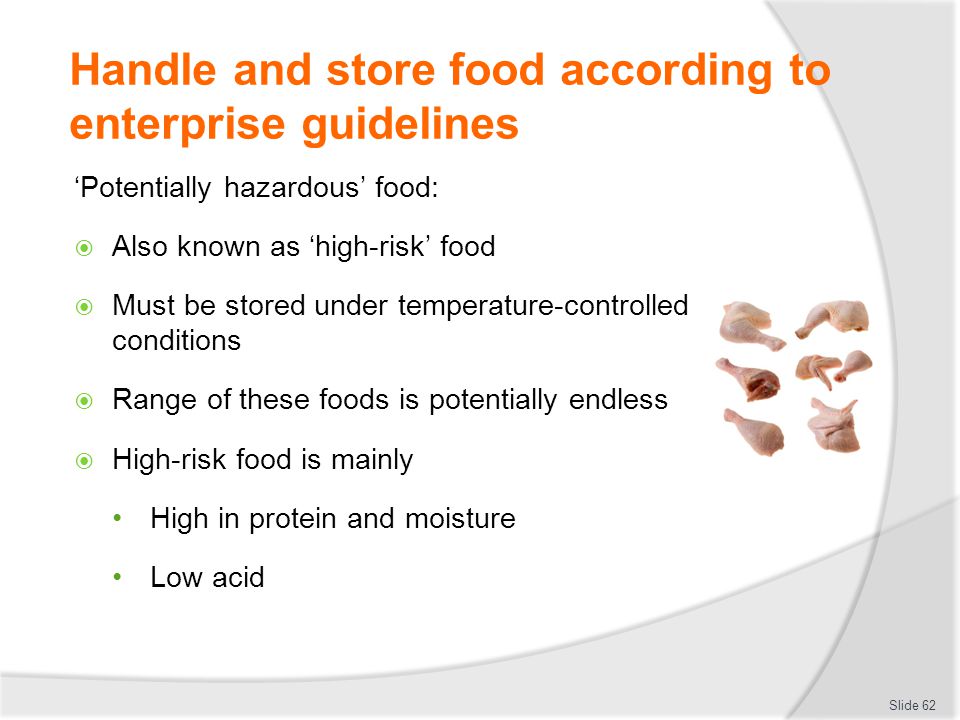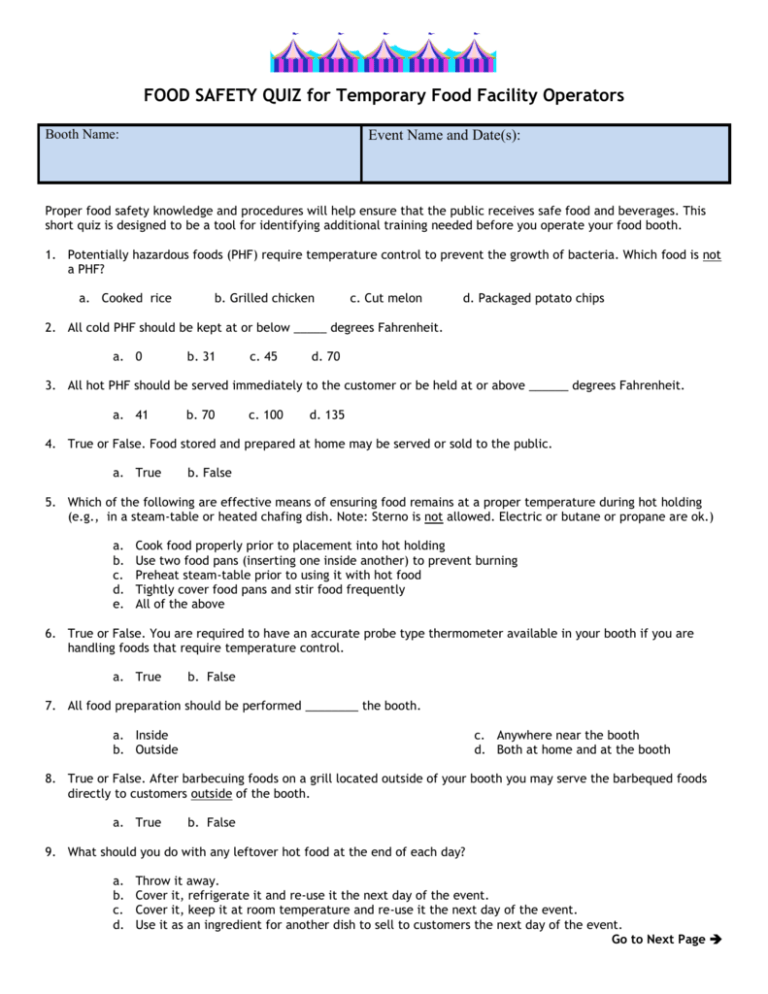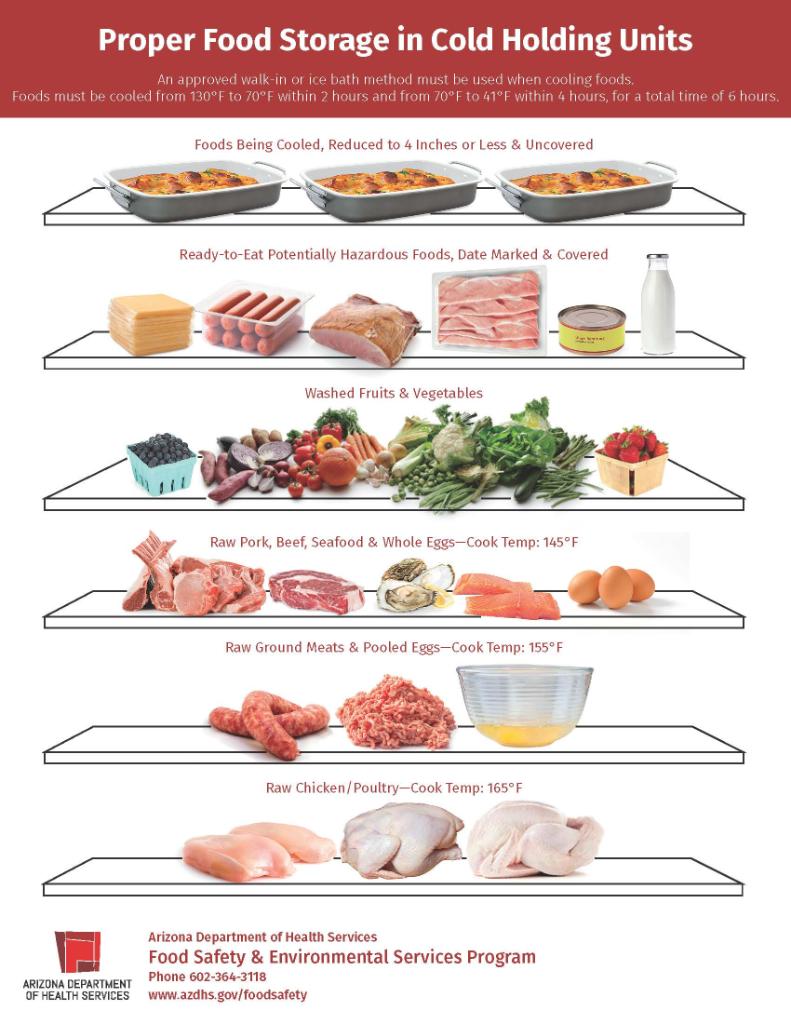potentially hazardous foods must be stored
When making cold salads such as tuna it is recomended that. MINIMUM TEMP FOR HOT FOOD STORAGE WITH THE.

Take A Look At Our Infographic On Safety Helmets An Important Part Of Any Worker S Ppe Kit Bigger Version Here Http Ow Workplace Safety Safety Helmet Ppe
Potentially hazardous foods must be held at 41 degrees Fahrenheit or less for cold-holding.

. The water should flow over the container edge to flush away impurities of the food. 1976 Food Service Sanitation Manual and the 1982 Retail Food Store Sanitation Code clarified that the food must be in. Financial Allocations Apportionments.
Maintain cold potentially hazardous food at. 1 rapid and progressive growth of infectious or toxigenix microorganisms. Raw and cooked meat or poultry foods containing eggs cooked or raw dairy products like milk cream and fresh custard seafood sprouted seeds like beans and alfalfa cut fruit and vegetables.
If making ice cream you must start with a pasteurized liquid ice cream mix. A container of refrigerated ready-to-eat potentially. True Which of the following steps in a Critical Control Point CCP during the food Flow for fried chicken.
This is because it takes more than 4 hours for food poisoning bacteria to grow to dangerous levels. Foods should not be kept in the Danger Zone for more than. The food must be completely submerged under potable running water at a temperature of 70F or below.
High School Equivalency Tests. A and B only When making cold salads such as tuna it is recommended that ingredients must be pre-chilled. High School Graduation Requirements.
Store potentially hazardous foods cold at or below 41 degrees Fahrenheit or hot at or above 140 degrees Fahrenheit to prevent the growth of disease causing bacteriaProvide a food thermometer for monitoring food temperatures. This is because it takes more than 4 hours for food poisoning bacteria to grow to dangerous levels. Sushi and sashimi includes fish that is to be consumed raw marinated or partially cooked.
Prepared or when it is to be discarded. Food Should be discarded Potentially hazardous foods in the refrigerator storage must be discarded when the temperature is. EXCEPTION OF ROASTS WHICH MAY BE STORED AT 130.
Oil Mixtures Oil mixtures including garlic in oil are often overlooked as potentially hazardous foods. Storage Temperature Store at an internal temperature of 41F 5C or lower. Examples of potentially hazardous foods include.
The presence of microorganisms is a form of. PHF must be stored and displayed below 5C or above 60C PHF must be thrown out if stored or displayed at temperatures between 5 and 60C more than four hours PHF must be used immediately if stored or displayed between 5 and 60C for. Potentially hazardous food is a defined concept identifying foods to be maintained at certain temperatures to minimize the growth of any pathogenic microorganisms that may be present in the food or to prevent the formation of toxins in the food ANZFSC Standard 322 cl.
Although potentially hazardous food should be kept at 5C or colder or 60C or hotter wherever possible this food can be safely between 5C and 60C provided it is between these temperatures for less than four hours. This is because it takes more than four hours for food-poisoning bacteria to grow to dangerous levels. Potentially hazardous foods should be kept at 5 C or colder or above 60 C wherever possible however ready-to-eat foods can safely remain between 5 C and 60 C for up to 4 hours.
Food that was received frozen should be stored at temperatures that will keep it frozen. Food held in the danger zone for. Refrigerated ready-to-eat potentially hazardous food prepared and held for more than 24 hours in a food establishment must be marked with the date of preparation and must be discarded if not consumed within 7 calendar days from the date of preparation.
Potentially hazardous food Potentially hazardous foods are foods that must be kept at 5C or colder or at 60C or hotter to minimise the growth of food poisoning bacteria that may be in the food or to stop the formation of toxins. Cooked or reheated food may be. Equipment must be capable of maintaining proper food temperature at all times.
Potentially Hazardous Foods Sushi Sashimi. If not quality and safety will suffer. Foods that have a water activity of 085 or above are considered.
Potentially hazardous foods are foods that need to be kept at certain temperatures to minimise the risk of dangerous microorganisms or toxins. The food item or items must be placed in a rimmed container such as a pot or bowl. Dispose of any food remaining at the conclusion of the event.
English Language Development Standards. Or cooled to. 70 f or above and between 41f and 70 for more than two hours.
Critique of FDAs potentially hazardous foods definition18. Executive summary potentially hazardous food phf must be displayed and stored in a manner that minimises the growth of pathogenic if attempted the food typically spends many hours at a perfect temperature for bacterial growth. Due to their varied natures and components different kinds of food need to be kept in specific.
These oil mixtures can contain the bacterium Clostridium botulinum if not treated to prevent. Adequate equipment must be provided for maintaining safe food storage temperatures. The Australian requirements for the storage and display of potentially hazardous foods are.
POTENTIALLY HAZARDOUS FOOD TEMPERATURE CHART. Potentially hazardous foods in the refrigerator storage must be discarded when the temperature is. Proper temperature must be maintained during food storage and transport.
The temperature of the thawed potentially hazardous food must not rise above. Potentially hazardous foods should be kept at 5 C or colder or above 60 C wherever possible however ready-to-eat foods can safely remain between 5 C and 60 C for up to 4 hours. Raw and cooked meat or foods containing.
Do not handle or prepare food for others. Food should be discarded. Flavorings toppings and marijuana infusion.
While most fresh potentially hazardous food should be stored at 41F 5C or lower others may have different temperature requirements. According to the FDA Food Code potentially hazardous food refers to natural or synthetic foods that require temperature control because they tend to have the following. Mussels clams crabs and lobsters should be purchased live from a.
Potentially Hazardous Food All potentially hazardous food should be kept below 41 o F for cold foods or above 135 o F for hot foods except.

Apply Standard Safety Procedures For Handling Foodstuffs Ppt Download

Special Events Food Safety Quiz

Restaurant Self Inspection Checklist How To Create A Restaurant Self Inspection Checklist Download This Restaurant Self Inspection Checklist Template Now

Apply Standard Safety Procedures For Handling Foodstuffs Ppt Download

The Flow Of Food Service Ppt Video Online Download

General Awareness Tips For Chemical Safety Chemical Safety Safety Courses Health And Safety

Lockout Tagout Poster Workplace Safety Slogans Occupational Health And Safety Safety Posters

توییتر Az Dept Of Health در توییتر Forget The Labels On The Refrigerator Bins For Food Safety Store Foods In Your Refrigerator According To Cook Temperature With Foods Requiring The

Lockout Tagout Think Before You Start Performing Maintenance Or Servicing Lockout Tagout Workplace Safety Health And Safety

404 Not Found Temperature Chart Food Temperature Chart Food Safety Temperatures

What Is Time Temperature Control For Safety Tcs

Storage 97 Types Of Storage Refrigeration Freezer Dry Storage Food Cleaned And Sanitized Equipment Chemicals Ppt Download

Potentially Hazardous Foods Health And Wellbeing Queensland Government

List Of Potentially Hazardous Foods

Potentially Hazardous Foods Health And Wellbeing Queensland Government

Learning Module Cookery Grade 10 Cookery Learning People Skills